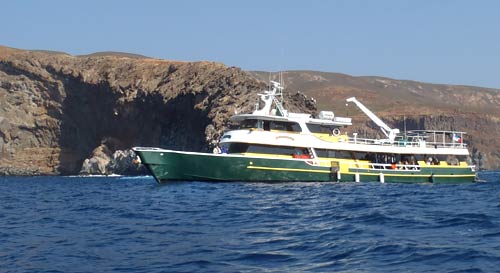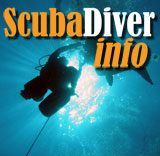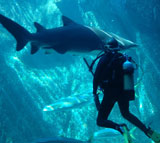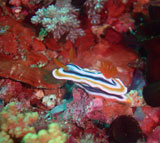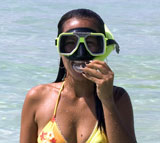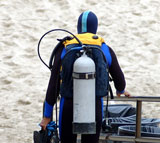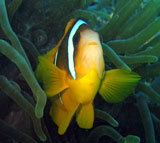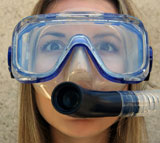This is a review and description of the eight day/eight night "live-aboard" dive trip to the Islas Revillagigedos (Socorro islands) onboard the Solmar V. The trip includes a 250 mile crossing to the islands (22-26 hours) and is famous for offering diving with giant mantas, sharks and other pelagics in dramatic, unspoiled environments.
Start and end: Starts and ends at Cabo San Lucas on the southern tip of Baja California, Mexico.
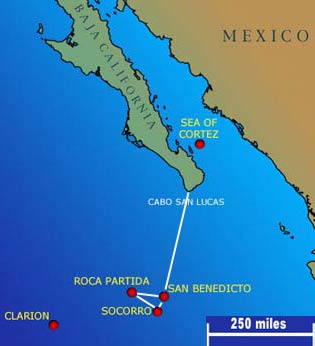 Solmar V/Socorro: The Solmar V is a 112-foot long, 28-foot wide live-aboard vessel providing all-inclusive live-aboard dive vacations. Trips start and end at the Cabo San Lucas Marina. Diving is divided into the islands of San Benedicto, Socorro and Roca Partida. Dive itineraries vary according to weather conditions, but usually begin at San Benedicto, the closest island, then continue at Socorro, and then Roca Partida. The three islands form a long triangle, with San Benedicto and Socorro being 35 miles apart, and the remote Roca Partida a further 70 miles from Socorro or 85 miles from San Benedicto out to sea.
Solmar V/Socorro: The Solmar V is a 112-foot long, 28-foot wide live-aboard vessel providing all-inclusive live-aboard dive vacations. Trips start and end at the Cabo San Lucas Marina. Diving is divided into the islands of San Benedicto, Socorro and Roca Partida. Dive itineraries vary according to weather conditions, but usually begin at San Benedicto, the closest island, then continue at Socorro, and then Roca Partida. The three islands form a long triangle, with San Benedicto and Socorro being 35 miles apart, and the remote Roca Partida a further 70 miles from Socorro or 85 miles from San Benedicto out to sea.
The Solmar V has 12 air-conditioned staterooms for a maximum of 22 passengers and usually a crew of about ten, including three divemasters. Each room has its own bathroom/shower, the diningroom/salon on the main deck is enclosed and air-conditioned, there is a small upper lounging and observation deck, food and drinks (including alcohol) are included, and depending on conditions, there will be about 20 dives on this itinerary.
Being on a live-aboard is the easiest and most relaxing way to dive because you never have to carry your gear around, and booking a trip on the Solmar V, which has served as a luxury live-aboard dive vessel since 1992, is a great way to get in some serious, and very unique diving.
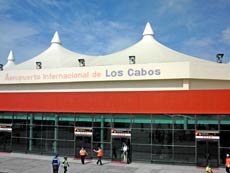 Arrival/customs: On your flight to the international airport at San Jose Del Cabo you fill out two simple customs documents. Upon arrival at the sizable and modern airport, immigration and customs are quick and hassle-free. Pushing a button at the customs gate triggers a green (pass) or red (get examined) light. Outside the secure area, dozens of time share salesmen will try to grab your attention and even pretend to be your contact. If you pre-book your airport transfer, your driver will wait outside the airport building with a sign. Do not get side-tracked! We used Cape Travel which had late model air-conditioned mini-buses and SUVs.
Arrival/customs: On your flight to the international airport at San Jose Del Cabo you fill out two simple customs documents. Upon arrival at the sizable and modern airport, immigration and customs are quick and hassle-free. Pushing a button at the customs gate triggers a green (pass) or red (get examined) light. Outside the secure area, dozens of time share salesmen will try to grab your attention and even pretend to be your contact. If you pre-book your airport transfer, your driver will wait outside the airport building with a sign. Do not get side-tracked! We used Cape Travel which had late model air-conditioned mini-buses and SUVs.
While Solmar V doesn't depart until 4PM or so, they strongly suggest you arrive at Cabo San Lucas the day before. Most guests will stay either at the very luxurious Solmar Suites or at the considerably less expensive Hotel Quinta del Sol by Solmar. We stayed at the Quinta del Sol, which is about a mile away from the marina.
The Quinta del Sol: The Quinta del Sol hotel is at the outskirts of Cabo San Lucas on the busy Blvd Lazaro Cardenas. This is essentially a motel type of place, but quite elegant and set back from the road. The rates are very reasonable (we paid US$60) and our room was large, clean, nicely air-conditioned, and even had a kitchenette. There is a small but elegant and crystal-clear pool for hanging out. No restaurant on the property, but there is a mini-mart with all essentials. Staff is very friendly and efficient, and well versed with Solmar V travelers. Soda machines only take pesos, but the mart takes dollars. There are about half a dozen restaurants and fast food places within walking distance. We ate at the Casa de Country and can highly recommend it for good, reasonably priced food (dinner for two with drinks US$40) and embiance. Self-serve breakfast is included at the Quinta.
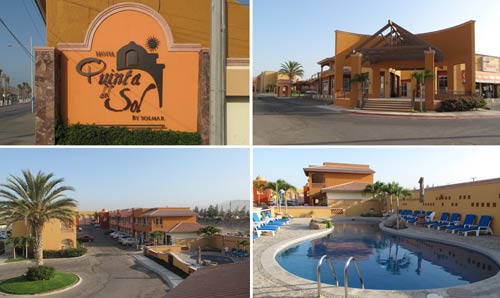
Getting to the Marina: Solmar V staff came to fetch us with SUVs and buses at about 1PM. It's a short one-mile ride from the Quinta to the nice and rather luxurious marina in the center of Los Cabos. Each dock has its own locked security gate. Below you can see one of the Solmar V's pangeros, Geronimo, greet Carol at the gate.
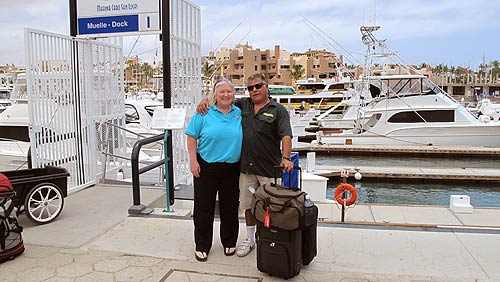
Arriving at the Solmar V: At the end of the dock was the Solmar V, with Captain Gerardo waiting and greeting us in his white captain's uniform. The first impression certainly was an excellent one. The Solmar V itself is sleek and elegant, all in green, gold and white.
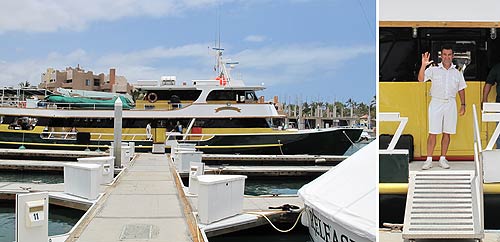
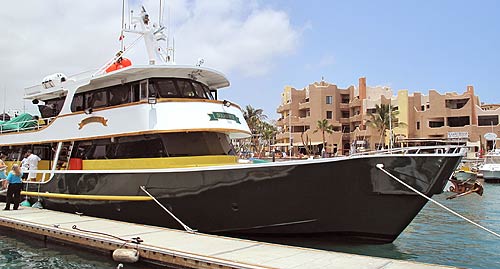
First impressions: When you step inside the salon on the main deck it's like stepping into an elegant lounge or pub, all in wood, polished brass and stained glass. There's pub-style lighting, too, and a large flat screen high definition TV. This is no boring cafeteria for sure!
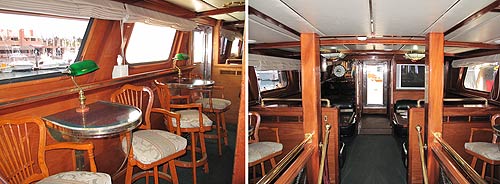
Two elegant staircases lead down to the lower deck where all the cabins are.
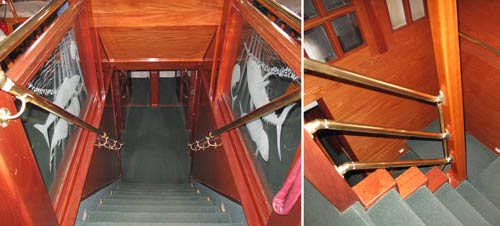
Rooms: The Solmar V has twelve staterooms, all on the lower deck, and separated into two blocks, each with its own staircase. The cabins offer a variety of single and double beds, most on two levels, so do spend some time figuring out what works best for you! We stayed in stateroom 304 towards the front of the vessel. All rooms are very small, so don't expect desk and much closet/storage space. There was one small cabinet to hang a few things, there are small cubbies next to each bed, but there is no storage space under the beds and no place to hang anything. So do pack lightly. Whatever bags and luggage you bring will need to be stored in a storage compartment on the main deck during the trip. There is an adequate number of American-style 110 Volt outlets for electronic gear. We had two plugs each by the sink and by the bed. The Solmar V allows charging of equipment in the rooms, and there are also a charging stations in the library and on the dive deck for camera and strobe batteries.
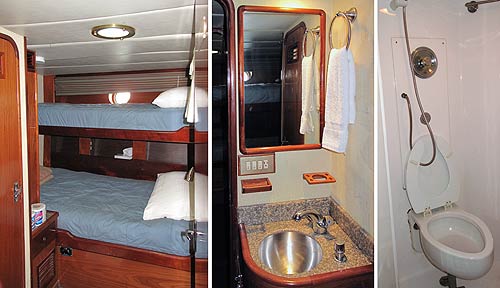
Each cabin has a small sink, and its own tiny bathroom that serves both as a toilet and shower in one. Fixtures, flushing and shower all worked fine and there was plenty of hot water with excellent water pressure. It's okay to drink the water as it comes from the boat's own onboard reverse osmosis systems. The bathroom has soap, shampoo and conditioner, but no hair dryer. There is no minibar or safe (neither are needed as you can always get what you want from the fridge/bar, and everything is totally safe).
The Solmar has excellent air conditioning throughout. In fact, sometimes we were almost too cold.
There are adequate towels. Towels are separated into inside and outside towels, and they are not to be mixed. Contrary to other live-aboards we've been on, you may wear shoes inside the Solmar V, and I missed not having flip-flops or Crocs with me.
The beds were exceptionally comfortable. Maybe it's because you sleep well after three or four dives, but I have hardly slept better. Pillows were comfortable, too. The crew makes up your bed while you are diving. Caution again: the bunks, and especially the upper bunks, are not for the claustrophobic or physically challenged. Below is the upper-level bunk I called my home while on the Solmar V.
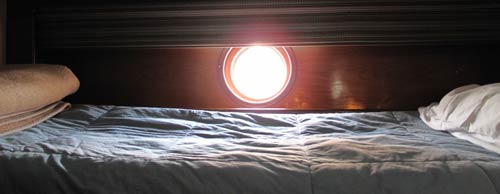
Below is the floorplan of the Solmar V.
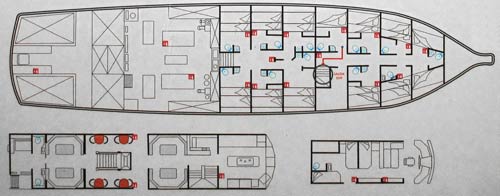
Lounge and entertainment: A live-aboard is not a cruise ship, so don't expect shopping, hot tubs or night clubs. The emphasis here is on diving, and there's so much diving that you'll likely be too tired to do anything but hit the sack! The Solmar V's common area is on the main deck and consists of a long pub-style lounge with booth and bar stool seating. It's all very elegant with lots of dark wood, polished brass, and stained glass. There is a large flatscreen TV used for briefings and entertainment, a DVD player, and a sound system. There are also books and magazines as well as board and card games. Since the Solmar V isn't very wide, traffic in the common area can get a bit congested.
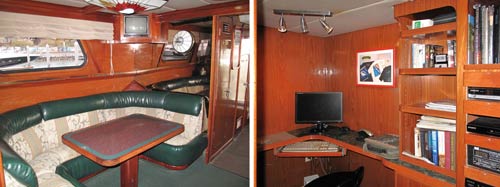
The Solmar V has a maximum capacity of 22 guests, and we had an almost full load with 21. On some boats that would present a problem, but not on the Solmar V where we always found room to sit both in the lounge and upstairs on the sun deck. Eating and hanging out in the elegant and nicely air-conditioned lounge was a treat compared to other live-aboards we've been on The upper deck, while not very large, offered a perfect combination of openness and shelter. There are reasonably comfortable lounge chairs and stargazing at night is a treat. Perhaps best of all, you never have to worry about mosquitoes or other bugs. There aren't any!
Crew: On our trip, we had an all-male crew of captain Gerardo; engineer Aurelio; dive masters Daniel, Erick and Rey; steward Luis; chef Tony; and pangeros Francisco, Luis and Geronimo. They were all exceptionally friendly, helpful and very competent. Captain Gerardo impressed with alternating between official white uniform and helping with the crew. The crew provided a perfect mix of unobtrusive service and friendly interaction. They were always there, but never got in the way. Although the entire crew was Mexican, there was no language barrier as everyone spoke at least passable English.
Food/Dining: Eating on the Solmar V is restaurant style in the dining room/lounge. There are four booths for four guests each, and four bar-style tables for two each. It can get a little tight, but worked amazingly well even with our full load of guests. All food is prepared on board by chef Tony.
For breakfast, there was always a large platter of fresh fruit on each table (melon, pineapple, strawberries, mango), and we had items like omelettes and eggs with ham or bacon cooked to order. There was a buffet with toast, muffins, pastries, croissants, French Toast, as well as a variety of cereals, yogurts, milk and fruit juices. The boat's coffee was strong and very excellent, and there was a variety of tea. Below you can see the bar area to the left and a peek into the well-stocked kitchen.
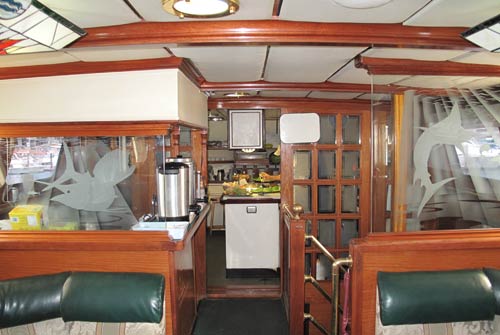
For lunch, we saw a variety of excellent soups and bisques, hamburgers and fries, club sandwiches with potate salad, enchiladas, rice and beans, fish filet, rice, broccoli, shrimp, pasta. For desert we had flan, ice cream, etc.
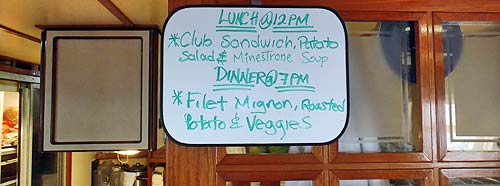
For dinner, chef Tony treated us to baked chicken with mashed potatoes, mixed vegetables and fruit tarts; a barbeque with chicken, beef, sausage, tortillas, guacamole and pico; chicken Alfredo pasta with mixed salad greens; filet mignon with mushroom sauce, roasted potatoes, carrots, broccoli, green salad and chocolate cake; Mango shrimp and vegetables; flank steak, beans, broccoli; T-bone steaks with baked potatoes, corn on the cob, etc. Guests with special dietary requirements were always accommodated.
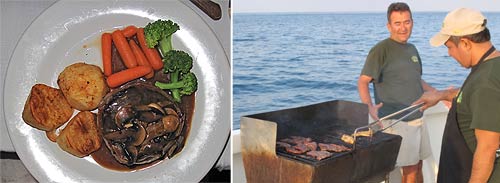
Snacks included elaborate cheese platters, fruit platters, crackers, quesadillas, fried cheese sticks, jalapeno poppers, chicken wings, brownies, fresh tuna, etc. Food was consistently excellent. Chef Tony did an outstanding job.
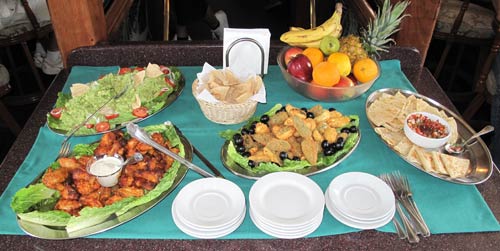
Bar/beverages: The Solmar V has a self-serve bar area in the main deck lounge that was always fully stocked with beer, red and white wine, spirits, milk, coffee, hot water for tea, juices, lime slices, and sweeteners. There was also a bar-style soda dispenser with a good variety of carbonated and non-carbonated drinks, but using it was trial and error due to a lack of labeling. The bar also had a large ice chest. On the dive deck is another large ice chest that was always stocked to the brim with various beers, sodas and juices in cans. Wine, beer and liquor was self-serve, but you could also ask the crew (which also makes great margaritas and pina coladas).
Suitability as a dive boat: The idea of a live-aboard is to make diving as easy as possible. This includes all the logistics of getting to dive sites, prepping gear, and getting in and out of the water as quickly and easily as possible. The Solmar V succeeds in virtually all areas.
The covered dive prep area is on the main deck right behind the main lounge, with your tank/BC sitting in a sturdy rubber ring. It also needs to be secured with a bungie cord. There's room to put fins and other items under the bench and each diver has a large plastic crate. You never have to move your gear during the entire trip. There is a place for cameras and you can hang your wetsuit on racks along the left and right side of the boat to dry in the wind. There's an adequate supply of spare parts, tools, batteries and other necessities. Even with a full boat (21), the space for divers was adequate.
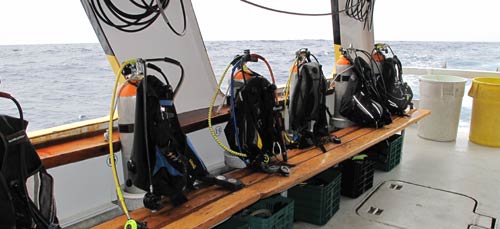
Dive briefings are all done right on the dive deck. The crew draws maps of the dive site on a white board and uses that to explain the site and the dive plan. Divers were divided into three groups, each with a dive master. Divers can join the dive master, or they are free to go by themselves, though solo dives are not allowed. I couldn't help but wonder how long it'll be until these briefings are all on flatscreen displays with all sorts of other pertinent data.
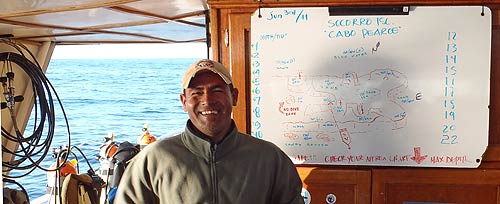
Diving on the Solmar V can be either directly from the boat, or from one of the two pangas. When diving from the boat, you get in the water by stepping of the large and sturdy dive platform at the stern of the boat. It's a couple of steps down from the main dive deck. Dive staff is always there to help you put on the fins, check your air, and hand you your camera. You get back on the boat via the large and very sturdy ladder. The latter is hinged and in rough waters it can pivot up and down quite a bit, so be careful. The dive deck has two shower heads with (usually) hot water for warming up and rinsing off.
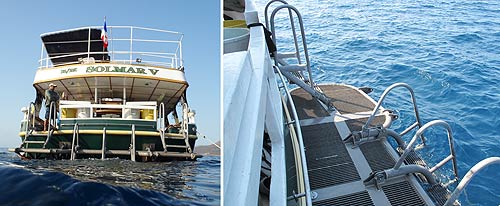
Below you can see a panga being loaded for a dive at Roca Partida. Getting in and out of the panga can be a bit of a challenge in rough water, and initially it seemed impossible that the small pangas could hold 11 divers with all their gear each. Or how one would get their dive gear on on the panga, and then, upon surfacing from a dive, take off the tank/BC in the water and hand it to the pangero for hefting up on the craft. Yet, it all works perfectly. Oh, and getting into the water from the panga requires synchronized action: One, two, three! and everyone falls in backward together.
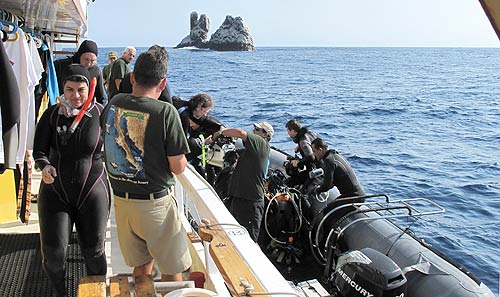

The captain's dive policy was maximum depth is 130 feet. Due to the average depth of the dives, most divers used nitrox. The Solmar V offers a maximum of 32%, though at times we saw up to almost 34%. It is the diver's responsibility to use one of the two oxygen sensors to check their nitrox, though no records are kept. Nitrox for the week costs US$125 per diver. For diving at Roca Partida, nitrox was 28% so that we could dive to 130 feet.
Maximum dive time from the boat is 60 minutes, from the pangas 50 minutes. Divers are, of course, expected to do a three minute safety stop at 15 feet. The boat has two weighted lines for safety stops, each with a regulator should someone be short on air.
Air: The boat has its own compressor system. Tanks are filled by the crew with compressor hose whips right where they are standing in their retainer rings after you take the BC/tank off after a dive. You never have to take the BC off or carry the tank around yourself. All tanks are standard 80 cubic-foot aluminum cylinders with US standard Yoke valves. Tanks are in good condition and fills were always 3,000+ psi.
As stated, 32% Nitrox is available on the Solmar V. Nitrox is highly recommended for the kind of diving you do on the Solmar as most dive sites are fairly deep and nitrox means not having to worry about remaining bottom time nearly as much.

Weights: Lead (and a few soft) weights are available onboard in whatever denomination you need. Ditto for weight belts.
Rental equipment: On a live-aboard, divers bring their own gear. The Solmar V, however, does have some spare parts in case someone forgets something or something breaks.
Diving: If you read on the Internet about Socorro diving, you'll find highest praise and reports from numerous happy return customers (we will be), but also some cautions that this is advanced diving and occasionally not for the faint of heart. Everyone agrees on the awesomeness of so much untouched nature and, of course, the mantas and other pelagics.
So here are the facts as we see them: while diving the Socorro islands off the Solmar V is not for beginners, it is also not only for experts. On our trip we had a great mix of younger and older divers, middle-aged couples on dive vacations, and even people who needed a bit of help with getting their gear in and out of the water. Getting in and out of the pangas and handling the occasional current requires a degree of physical fitness, but so does almost any type of diving. So anyone who can handle that will enjoy Socorro diving and be treated to seeing the giant mantas the Socorro islands are famous for, as well as numerous types of sharks, including perhaps whale sharks, dolphins and other large animals.
This time, our itinerary took us first to San Benedicto, a barren, uninhabited 2.3 square mile volcanic island of stark beauty where we encountered unseasonably cold water, as low as 66 degrees at the bottom, and several divers found themselves unprepared with 3-mil wetsuits or less. I was glad that I had brought my 7-mil. Visibility was less than expected, there was current, and we didn't see much on our first three dives other than a brief visit from Dolphins at the usually very productive El Boiler dive site. On the fourth dive, at Cape Fear, we finally saw Giant Pacific Mantas, several of them! Below you can see the Solmar V approaching San Benedicto after a 22-hour ride from Cabo.
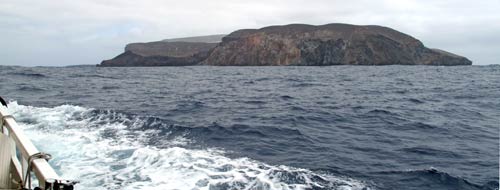
The most recent massive lava erruption on the side of the volcano enlarged the island with a black lava peninsula.
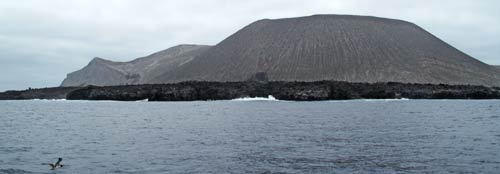
San Benedicto is famous for its mantas. Mantas are massive filter feeders that can reach a width of 25 feet and a weight of almost 3,000 pounds. Mantas are among the most majestic, graceful and elegant creatures on earth, and seeing them in their natural habitat is a total, breathtaking treat.

The much larger island of Socorro, about 50 square miles and also volcanic—but greener than San Benedicto—is 35 miles away. We did three dives at Cabo Pearce where the water was a more agreeable 75F. Cabo Pearce, on the southeast side of Socorro, is an underwater ridge that runs from the shore out a few hundred feet and turned out to be a good location for wonderful manta encounters, and we also saw dolphins and some sharks. Only three dives here as in the afternoon we approached the small Mexican naval station so that personnel could board and perform their routine registration and (unobtrusive) inspection the Solmar V.
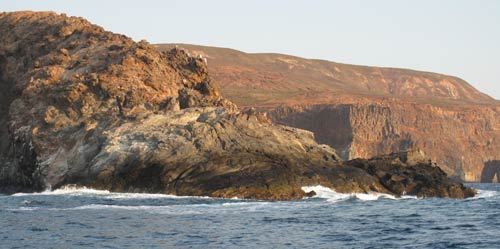
The scenery is rough, grand and wild, and you're always aware that you're far from civilization, alone with nature at its very best. There are also incomparable sunrises and sunsets.
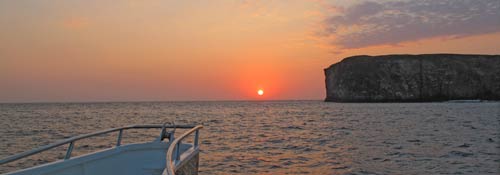
Geronimo, our pangero, took us on panga rides close to San Benedicto and Socorro. If you're on the Solmar V, do not miss those opportunities!
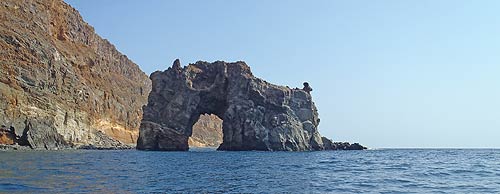
You never knew when dolphins would show up. Sometimes they played around the Solmar, other times around the pangas.


The whale shark below was sighted by our intrepid videographer, Adil Schindler. I so wish I had seen it, too!

Roca Partida—a twin lava tube pinnacle sticking out of the sea by some 90 feet—is another 85 miles past Socorro, and one of the most remote dive locations most will ever visit. The rock sits in about 220 feet of water, so on good days you can glimpse the bottom. There were swells and all three dives at Roca Partida were from pangas. Underwater, the site presents a massive almost vertical rock face with an incredible wealth of all sorts of fish. We saw various sharks, predominantly white tips (including many stacked up like cord wood in alcoves in the rock), but also silkies, galapagos, silver tips, hammerheads, etc. We did a clockwise and two counterclockwise dives, always ending in blue water where we were totally surrounded by large fish. Divers need to watch the current here, and we recommend a leisurly pace as there is much to see.

Here's a closer look at Roca Partida. About 90 feet stick out of the water. Underwater it looks much more impressive, just massive vertical walls and tons of fish.

Unlikely bed fellows for sure. Yet, somehow the white tip sharks and the very large moray seem to get along.
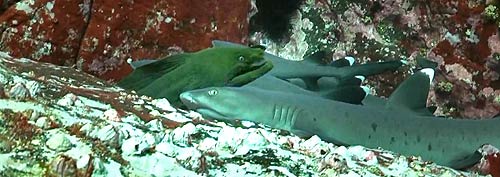
The Solmar V then returned to Socorro for two more dives at Cabo Pearce (dolphins, mantas, southern sting rays, etc.) and one each at Punta Tosca on the western side of Socorro and Roca O'Neal. The final day of diving was at San Benedicto where the usually productive El Canon—a canon-shaped group of pinnacles—yielded little. Diving concluded with three marvelous dives at Cape Fear on the north end of San Benedicto, where we had awesome extended giant manta encounters in good visibility.
Below are the dive sites we visited, including my max depths on each.
Wednesday, June 1, San Benedicto:
- El Fondeadoro (87 feet, 43 minutes, 67F, boat in/back)
Thursday, June 2, San Benedicto:
- El Boiler (91 feet, 41 minutes, 67F, boat in/back)
- El Boiler (83 feet, 41 minutes, 67F, boat in/back)
- Cape Fear (91 feet, 51 minutes, 68F, boat in, panga back)
- Cape Fear (skipped, panga)
Friday, June 3, Socorro:
- Cabo Pearce (skipped, snorkeled instead)
- Cabo Pearce (92 feet, 45 minutes, 75F, boat in, panga back)
- Cabo Pearce (90 feet, 31 minutes, 75F, panga in/back)
Saturday, June 4, Roca Partida:
- Roca Partida (95 feet, 44 minutes, 76F, panga in/back)
- Roca Partida (111 feet, 49 minutes, 75F, panga in/back)
- Roca Partida (113 feet, 50 minutes, 75F, panga in/back)
Sunday, June 5, Socorro:
- Cabo Pearce (100 feet, 63 minutes, 75F, boat in/back)
- Cabo Pearce (100 feet, 62 minutes, 77F)
- Punta Tosca (100 feet, 41 minutes, 74F, panga in/back)
- Roca O'Neal skipped (panga)
Monday, June 6, San Benedicto:
- El Canon (100 feet, 51 minutes, 71F, boat in/back)
- Cape Fear (97 feet, 50 minutes, 70F, boat in/back)
- Cape Fear (79 feet, 54 minutes, 72F, boat in/back)
- Cape Fear (skipped, panga)
Note that no two live-aboard trips will likely ever be the same as weather and other conditions may determine where the captain will take the boat. Carol had been on the Solmar V in December 2005 and had great weather and visibility. On our June 2011 trip we had nice weather, though a bit windy, but visibility was less than expected, the water at San Benedicto was unseasonably cold, and Roca Partida, while still spectacular, had according to our dive masters less fish life and visibility than usual.

Now here a few informational items about Solmar V trips.
Computers/Internet: There is no standard internet access on the boat, but the Solmar V has an onboard satellite communication system where you can, at your own cost, set up an email or phone account with the Solmar V's provider. This is used via a public computer next to the lounge area. This is not for web browsing, though. While docked at the Cabo San Lucas marina, there are a couple of unlocked WiFi hotspots, but they have weak signals and are very slow.
Cellphones: Unless you make prior arrangement with your cellphone vendor for international coverage, you won't be able to use your phone. When we arrived in Cabo, I received a text from AT$&T informing me that I could make calls for US$0.99/minute and could use data at the (outrageous) rate of US$19.97/megabyte.
Security: The spiffy Cabo San Lucas marina is right in town, with plenty of security. Each dock has its own modern security gate. Once underway, the boat's completely safe. There is no need to lock doors or anything.
Vendors: There is no dedicated shop onboard the Solmar V. They do, however, sell a variety of T-shirts, hats, sweat shirts, etc. They are not inexpensive, but make for good mementos. We bought nice green fleeze sweatshirts with embroidered Solmar V logos as we had not brought enough warm clothing!
Cabo San Lucas, of course, has plenty of shopping within walking distance of the boat, ranging from very inexpensive apparel and trinkets to the most exclusive designer brands.
Weather: Do realize that the Solmar V takes you hundreds of miles out into the Pacific ocean, far from land and quite exposed. This means that you may or may not encounter weather that can affect diving and conditions. On our trip in June of 2011, we started with mildly overcast weather in Cabo San Lucas, but had sun the rest of the trip. It was a bit cooler and much windier than we had expected, and that meant fairly choppy waters and large swells, with at times substantial currents and surge. Weather conditions often dictate the itinerary and choice of dive sites when on the Solmar V. Having brought too many warm clothes on prior live-aboard trips, I didn't have enough on the Solmar, so do bring some warm gear just in case.
Cost: The per person list price for a Socorro dive trip on the Solmar V is US$3,199 for standard rooms and US$3,299 for superior rooms. There is no fuel surcharge, but there is an 11% tax. There isn't that much of a difference between the room types, but since all rooms are very small, even a bit of extra space can make a difference, and so we'd definitely pay the extra money for a superior room.
The Solmar V didn't nickel and dime us, with the only extra expense the airport transfers and $15/person for the marine park. There was no departure tax in Cabo San Lucas on the way home. US Air charged us even for the first checked bag on the way to Cabo, but not on the way back.
Tips: Solmar literature suggests that you're paying a tip of 8-10% of the total package price (not including flight) at the end of the trip. This is all very informal; you're not summoned to a final settlement with the purser. The tip goes into a pot which will then be distributed among all crew. As always, if you're particularly pleased with someone, you can tip them separately.
Bottom Line: If you love to see unspoiled nature at its best, love to see giant mantas, sharks of all kinds, and other large pelagics in one of the few habitats where you can truly see them, a trip to the Revillagigedos islands on the 112-foot Solmar V is a unique, wonderful opportunity that you'll never forget. The Solmar V is luxurious, the food is great, the crew competent and friendly. Realize that the ocean passages are long and even the trips between islands can be a bit rough, the rooms are quite small, and you do need passable diving skills and preferrably nitrox certification. If you're okay with that, put a Socorro trip on the Solmar V on your bucket list.
Contact: www.solmarv.com, call 310-455-3600, or check the reservation page here.
